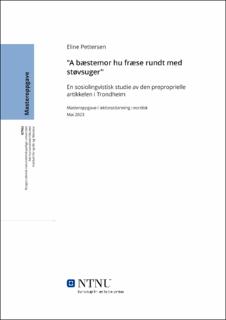| dc.contributor.advisor | Hårstad, Stian | |
| dc.contributor.author | Pettersen, Eline | |
| dc.date.accessioned | 2023-07-26T17:19:30Z | |
| dc.date.available | 2023-07-26T17:19:30Z | |
| dc.date.issued | 2023 | |
| dc.identifier | no.ntnu:inspera:138868559:38232661 | |
| dc.identifier.uri | https://hdl.handle.net/11250/3081510 | |
| dc.description.abstract | Denne oppgaven er en sosiolingvistisk studie av den preproprielle artikkelen i Trondheim. Korpusmateriale fra 1970-tallet og eldre lokal dialektlitteratur fra så langt tilbake som sent 1600-tall, viser at den preproprielle artikkelen tradisjonelt har vært et språktrekk som har blitt mye brukt i Trondheim. Formålet med oppgaven er å undersøke bruken av artikkelen i dag, og om det finnes aldersvariasjon i bruken av den. Gjennom det jeg har valgt å kalle for «eksperimentell informantsamtale», hvor artikkelen har blitt framprovosert, har jeg samlet inn data som viser at artikkelen forekommer svært sjeldent og sporadisk i trondheimsdialekten i dag. Samtidig viser datamaterialet også at eldre trondheimere bruker den preproprielle artikkelen mer enn yngre trondheimere, hvor de to yngste informantene ikke brukte artikkelen i det hele tatt. Dersom man støtter Labov sin tanke om å studere språket synkront i tilsynelatende tid, for å kunne se hvordan språket vil se ut i reell tid, vil man kunne anta at vi står ovenfor en pågående språkendring knyttet til bruken av artikkelen i Trondheim. Samtidig er blant annet age-grading et begrep som gjør det problematisk å trekke konklusjoner om fremtidens språk. Selv om det er vanskelig å si konkret hvordan situasjonen for den preproprielle artikkelen vil være i fremtiden, viser resultatene mine fortsatt at artikkelen står i en tilbakegang i Trondheim. En mulig forklaringsfaktor for tilbakegangen kan derimot komme fra standardspråkpåvirkning. | |
| dc.description.abstract | This thesis is a sociolinguistic study of the preproprial article in Trondheim. Corpus data from the 1970s and old literature on the local dialect from as far back as late 1600 shows that the preproprial article traditionally has been a language feature that has been used a lot in Trondheim. The purpose of this study is to survey the use of the preproprial article today, and to see if there is an age difference in the usage of it. Through my method, which I have called “experimental informant conversation”, where the preproprial article was provoked, have I gathered data that shows that the article appears rarely and sporadically. At the same time, the data also shows that the older speakers use the preproprial article more often than the younger speakers. My two youngest informants didn´t use the article at all. If one supports Labov’s idea about studying language in apparent time to find out how the language will look in real time, one could assume that the preproprial article in Trondheim is under a process of language change. At the same time is age-grading, among other things, a term that causes problems in assuming how the future language will look like. Although it´s hard to say something concrete about the situation for the preproprial article in the future, my results still shows that the article has lost ground in Trondheim. One possible explanation for this comes from impacts form standard language. | |
| dc.language | nob | |
| dc.publisher | NTNU | |
| dc.title | A bæstemor hu fræse rundt med støvsuger | |
| dc.type | Master thesis | |
